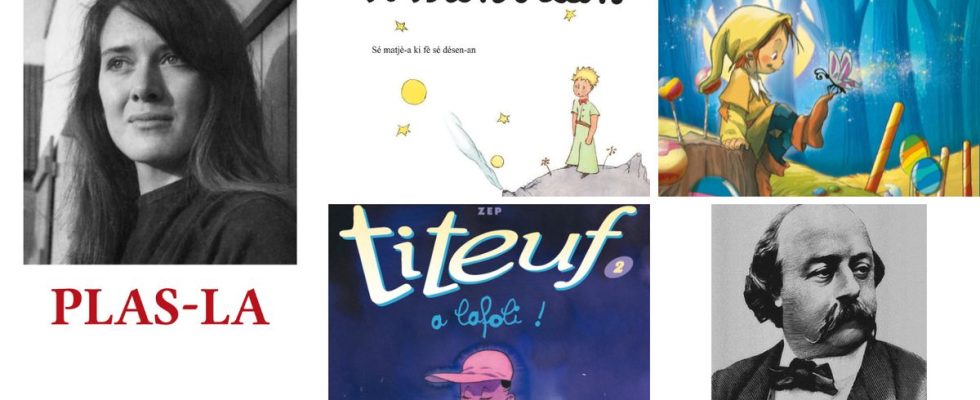If I tell you Zouk la sé sèl médikaman nou ni, do you answer me? Yes, Kassav’. The interplanetary hit is one of the flagship pieces of the famous West Indian group. And one of its specificities is that it is written in Creole (like all the group’s songs). A bias taken by the group which demonstrated the richness and poetry of the language to its millions of listeners.
French-based Creole is estimated to have nearly ten million speakers, according to the latest statistics. It is spoken by seven million people in Haiti, where it is the official language, and 1.6 million in French overseas territories. Long transmitted orally, Creole has now found its place in administrations, particularly in Martinique. In literature, there are many renowned writers such as Patrick Chamoiseau, Dany Laferrière and Ernest Pépin, but also translations of several classic works, such as The little Princetranslated into Guadeloupean, Martinican, Guyanese and Reunionese Creole, by the Caraïbéditions publishing house.
From Asterix to Albert Camus
“It was surprising that Creole was not a language of apprehension” for a translation, recalls Florent Charbonnier, founder of Caraïbéditions in 2006. At the time, he made the crazy bet of offering a translation into Creole of the popular comic strip, Asterix. “We negotiated with Albert Uderzo on the condition of having the best translator,” he says. The choice will fall on Hector Poullet, lexicographer, translator and author of the first Guadeloupean-French Creole dictionary in collaboration with Sylviane Telchid. Accompanied by Jean-Marc Rosier, he translates The great dividethe 25th Asterix comic strip, called Grand Kannal-la in Creole.
“We subsequently did, Tintin, Titeuf, The little Nicolas, Grimm’s Fairy Tales in several Creoles,” explains Florent Charbonnier. With the Martinican novelist, Raphaël Confiant, the publishing house also publishes translations of The Stranger by Camus (Moun-andéwo) or the first global translation, just before German, of War by Louis-Ferdinand Céline (Ladjè-a). And more recently, she promoted the releases of works in Creole by Annie Ernaux, The place (Plas-la) and D’A simple heart by Flaubert (An Tje San Ganm).
Linguistic tour de force
But what is the point of these translations? On the one hand, to test and strengthen the language whose written codes are still young. “The Creole language is a language that was suppressed for a very long time: we would not be allowed to talk about it in the administration, nor to learn to write it because it was spoken by slaves,” explains Kofi Jicho Kopo, cultural influencer, radio columnist in Martinique and Creole language trainer. “We still lack words. We must form neologisms to describe our current realities in Creole,” he adds. On the other hand, to satisfy several audiences: schoolchildren (students in LLLCER Creole and students of Capes Creole), the curious, but also those speaking Creole more easily than French to have easier access to culture. “When I do training, I like to provide translations. It surprises, it amuses the public, it makes them proud to see The Miser And Don Juan in Creole. Very often people have the impression that Creole cannot do that,” notes Kofi.
For the actors interviewed, a good translation is a linguistic tour de force: no question of making adaptations, but real translations. Thus, an apple will not become a guava, due to an “exotic” effect. “A good translation is when the reader reads, he does not wonder what Creole means in French, he is immersed in the text. I also sometimes take words from other Creoles, rather than creolizing a French word, but we must not overdo it,” believes the Martinican host. For example, to say “dehumanize” in French, there is the word “démouné” in Guadeloupean Creole. To have it in Martinican Creole, he borrowed it and transformed it with the linguistic codes to obtain “démounen”.
Florent Charbonnier, for whom the choice of translator remains crucial, remembers seeing people spend days on a phrase or a pun. He gives the example of Raphaël Confiant on the text of War. “Céline has a real language of his own. In Creole, it was necessary to maintain the originality of the text. For The Stranger from Camus, he went to pick up words in Haitian Creole and even Seychelles,” he says. In the foreword of Plas-la, Hector Poullet explains these translation difficulties with the work of Annie Ernaux, “more than once I made nonsense and even misinterpretations in a first draft. For example, when the author says that it is hot in the kitchen, I deduce an expression of discomfort, because in my daily life, in Guadeloupe, when we talk about heat it is to complain about it and not to ‘rejoice in it. For me, they are hot, therefore ‘too’ hot, so much so that I necessarily translate the sentence wrongly.
Intergenerational wealth
And what to do when there is a generation gap between the translator and the work? In the case of Titeuf, the problem arose for the publishing house Caraïbéditions. Hector Poullet and Robert Chilien “did not know the schoolyard expressions” used by the little boy with the yellow locks, Florent Charbonnier noted at the time. They then had the idea of going to meet a CM2 class and their Creole LLCER teacher: “We made them a list of expressions that we had to translate without showing them the work”. The great translators have thus nourished themselves with the words of children. “We released the comic book plus a glossary, because they had given us so many expressions,” the publisher still laughs.
Creole continues to enrich itself. To mark the month dedicated to Creole, the publishing house has also released a new dictionary, this time dedicated to swear words. Enough to further spice up and fuel the vocabulary of speakers or journalists of 20 minutes to prepare for the next dictation in Creole to discover in the video at the top of the article.

